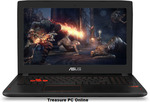A refurb, but Fantastic laptop for this price…
Specifications:
Manufacturer NumberGL502VM-FY015T 16GBProcessorIntel® Quad Core™ i7 6700HQ Processor(2.6~3.5Ghz X4)Operating SystemWindows® 10Memory8 GB DDR4 2133 RAM upgraded to 16GBDisplay15.6" (16:9) LED backlit FHD (1920x1080) 60Hz Anti-Glare Panel with 72% NTSC with G-Sync wideview technologyGraphicDedicated NVIDIA GeForce GTX 1060 with 6GB GDDR5 VRAMStorage128 GB SSD +1TB HDDCameraHD CamNetworking
WiFi—- Integrated Intel Dual Band AC8260
RJ45—-Gigabit Realtek Lan
BT 4.0 support (on WLAN+ BT 4.0 combo card)
Interface
1 x Microphone-in/Headphone-out jack
1 x Type C USB3.0 (USB3.1 GEN1)
3 x Type A USB3.0 (USB3.1 GEN1)
1 x RJ45 LAN Jack for LAN insert
1 x HDMI
1 x mini Display Port
1X AC adapter plug
Audio
Support Windows 10 Cortana with Voice
ASUS SonicMaster Technology
Battery
4Cell 64Whrs Battery
Dimensions
39.0 x 26.6 x 2.35 cm (WxDxH)
Weight
2.24 kg (with Polymer Battery)
Manufacturer Warranty1 year Asus pick up & return warranty
http://www.ebay.com.au/itm/Asus-ROG-GL502VM-FY015T-Laptop-i7…






Good price however refurbished.
The Acer Predator Helios 300 Gaming Laptop, Intel Core i7 CPU, GeForce GTX 1060 6GB, VR Ready, 15.6" Full HD, 16GB DDR4, 256GB SSD, Red Backlit KB, Metal Chassis, G3-571-77QK
Is about AUD 1,673.10 after shipping and handling and import fees desposit is considered and calculated. Also no AU plug only US.
Not sure of the panel quality of each one but the only real differences are the increased SSD storage space and more stronger cpu on the Acer Predator Helios 300.
Weight is also increased on the Acer at 2.7 kg vs 2.24 kg on this Asus so that could be a deciding factor.